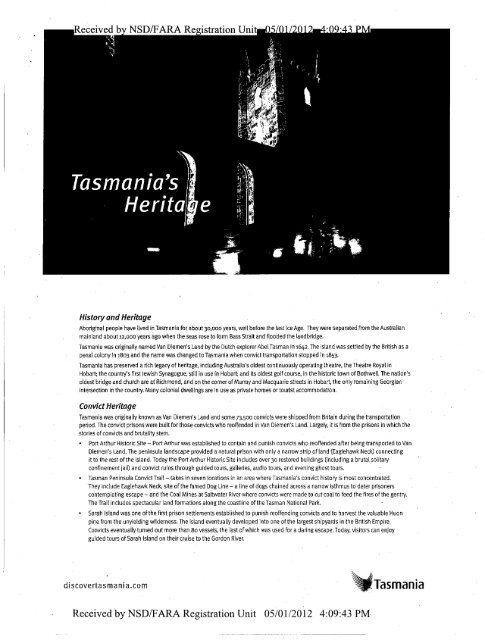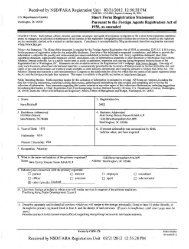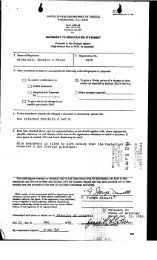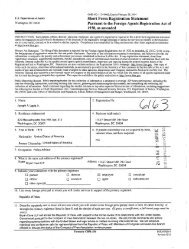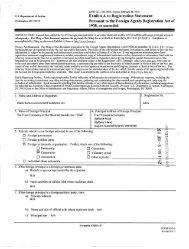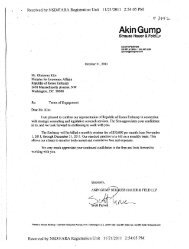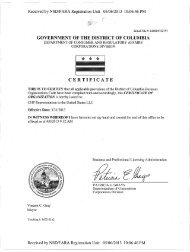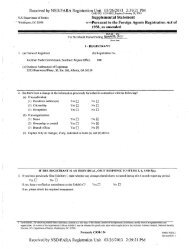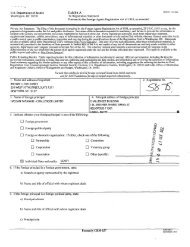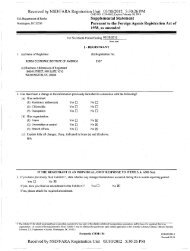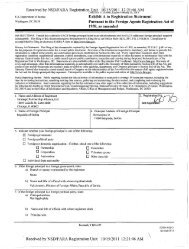Supplemental Statement - FARA
Supplemental Statement - FARA
Supplemental Statement - FARA
You also want an ePaper? Increase the reach of your titles
YUMPU automatically turns print PDFs into web optimized ePapers that Google loves.
eceived bv NSD/<strong>FARA</strong> Registration Uni<br />
Tasmania s<br />
History and Heritage<br />
iMli<br />
•>-..<br />
;Kl_«ft.<br />
m<br />
- m<br />
V* •' ...<br />
*-„' 1<br />
wi.<br />
n W ; ^*<br />
Aboriginal people have lived in Tasmania for about 30,000 years, well before the last Ice Age. They were separated from the Australian<br />
mainland about 12,000 years ago when the seas rose to form Bass Strait and flooded the landbridge.<br />
Tasmania was originally named Van Diemen's Land by the Dutch explorer Abel Tasman in 1642. The island was settled by the British as a<br />
penal colony in 1803 and the name was changed to Tasmania when convict transportation stopped in 1853.<br />
Tasmania has preserved a rich legacy of heritage, including Australia's oldest continuously operating theatre, the Theatre Royal in<br />
Hobart; the country's first Jewish Synagogue, still in use In Hobart; and its oldest golf course, in the historic town of Bothwell. The nation's<br />
oldest bridge and church are at Richmond, and on the corner of Murray and Macquarie streets in Hobart, the only remaining Georgian<br />
intersection in the country. Many colonial dwellings are in use as private homes ortourist accommodation.<br />
Convict Heritage<br />
Tasmania was originally known as Van Diemen's Land and some 73,500 convicts were shipped from Britain during the transportation<br />
period. The convict prisons were built for those convicts who reoffended in Van Diemen's Land. Largely, it is from the prisons in which the<br />
stories of convicts and brutality stem.<br />
• Port Arthur Historic Site - Port Arthur was established to contain and punish convicts who reoffended after being transported to Van<br />
Diemen's Land. The peninsula landscape provided a natural prison with only a narrow strip of land (EaglehawkNeck) connecting<br />
it to the rest of the island. Today the Port Arthur Historic Site includes over 30 restored buildings (Including a brutal solitary<br />
confinement jail) and convict ruins through guided tours, galleries, audio tours, and evening ghost tours.<br />
• Tasman Peninsula Convict Trail - takes in seven locations in an area where Tasmania's convict history is most concentrated.<br />
They include Eaglehawk Neck, site ofthe famed Dog Line - a line of dogs chained across a narrow isthmus to deter prisoners<br />
contemplating escape - and the Coal Mines at Saltwater River where convicts were made to cut coal to feed the fires ofthe gentry.<br />
The Trail includes spectacular land formations alongthe coastline of the Tasman National Park.<br />
• Sarah Island was one ofthe first prison settlements established to punish reoffending convicts and to harvest the valuable Huon<br />
pine from the unyielding wilderness. The island eventually developed into one ofthe largest shipyards in the British Empire.<br />
Convicts eventually turned out more than 80 vessels, the last of which was used for a daring escape. Today, visitors can enjoy<br />
guided tours of Sarah Island on their cruise to the Gordon River.<br />
discovertasmania.com Tasmania<br />
Received by NSD/<strong>FARA</strong> Registration Unit 05/01/2012 4:09:43 PM


